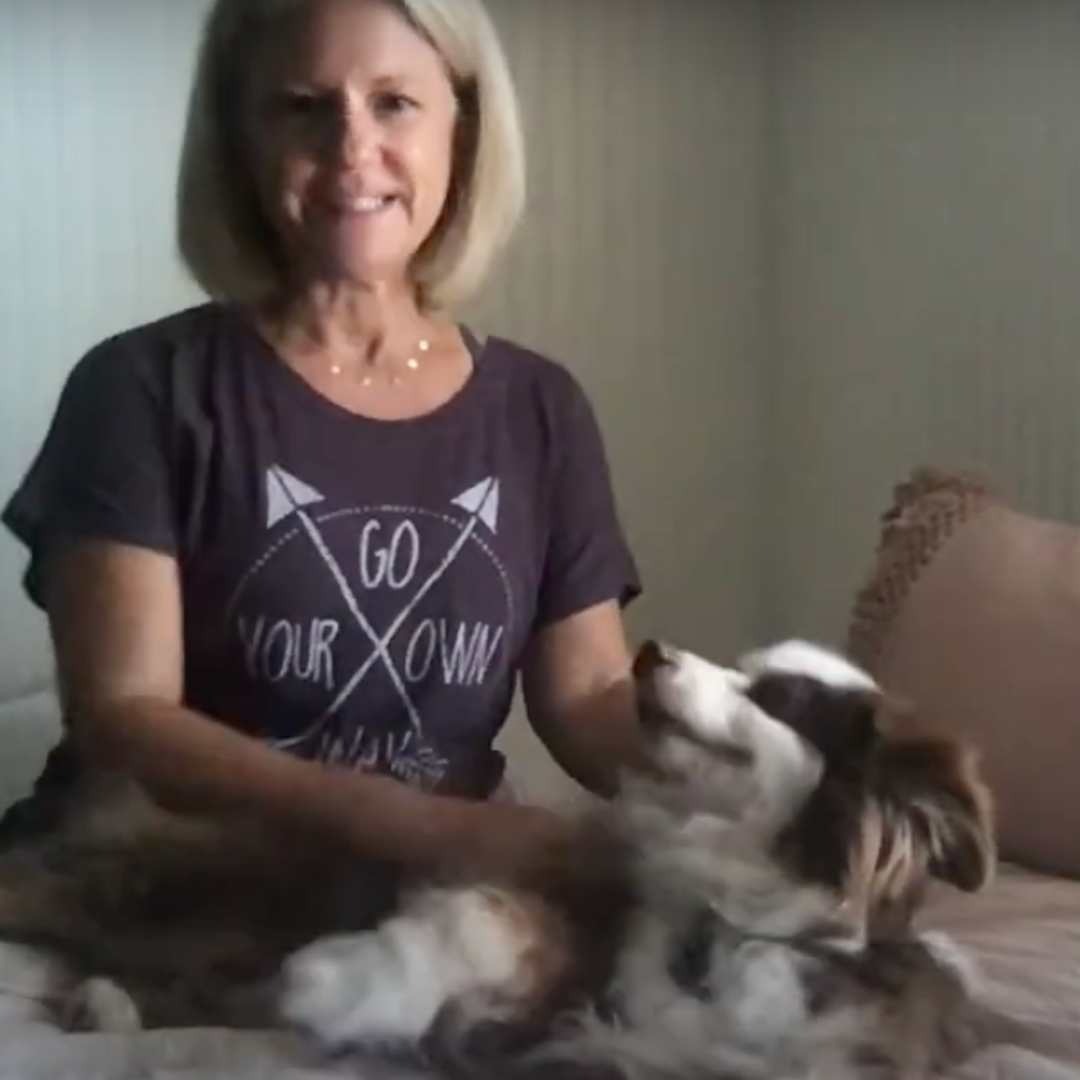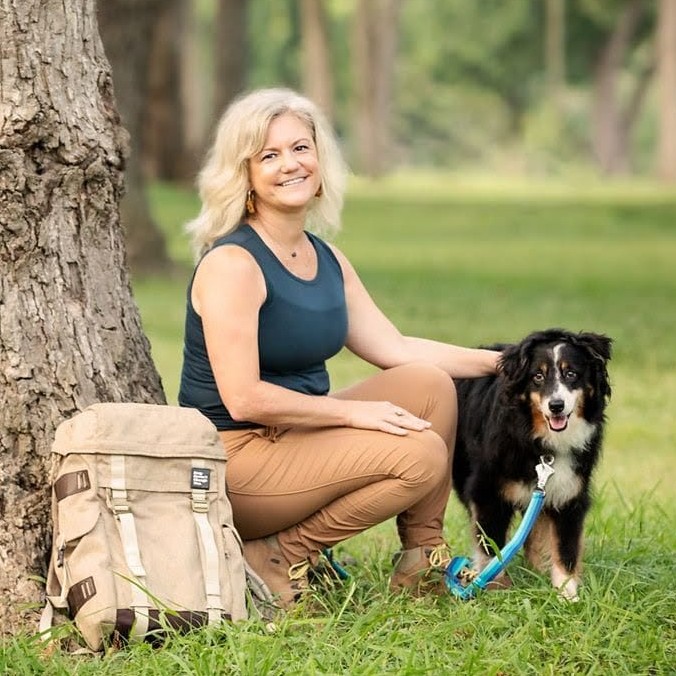Learn how to do the half-moon stroke, another go-to canine massage technique as you work with your dog's entire body for all the benefits of dog massage.
You can follow along in the video below with your dog as I demonstrate the half-moon therapeutic massage technique with my dog Daisy. (And see a quick recap of the first 2 skills: effleurage and the kneading stroke.)
The half-moon is a pain-relieving, soothing massage for your dog - perfect for back legs, gluteals - and a particularly good canine massage technique for senior or athletic dogs or any dogs who might be likely to strain muscles/joints with off-kilter jumping or running.
Stop! Don't read this long article. Instead, get everything you need to know, including all advice on Massage, in a customizable step-by-step plan for your dog created by our community of certified trainers and nutritionists.Your Dog's Plan
Why dog massage using the half-moon stroke works
We've learned effleurage and the kneading stroke in earlier guides, so now let's add the half-moon stroke to your canine massage techniques to give you choices for what's right at any given time for each part of your dog's body.
The half-moon stroke might look a bit like gentle petting but it's much more purposeful and grounded in science.
Much like effleurage, the half-moon is an open-handed, gentle massage stroke without too much pressure that has multiple benefits:
- warms the body
- increases blood flow
- helps to remove fluids and toxins
- boosts the immune system
- helps relieve pain
- and thoroughly relaxes your dog
How to massage your dog using the half-moon stroke
#1: Get grounded (always!)
Every massage session begins with grounding for pet owners and your dog. Settle into a soft spot, with both hands lightly on your dog, focus on your dog and feel the energy between you, visualizing it connecting through your hands.
Even setting aside just a few minutes each day or every few days for your massage sessions can make a visible difference in your dog physically and in both of you mentally and energetically.
Massage
Interested in Massage? Follow topics you're interested in to customize your dog’s step-by-step plan so it's most helpful and tailored to your dog when you're ready to get started.
#2: Work your open hands in a sweeping circular motion
The half-moon is an open-handed stroke like the first effleurage technique you learned. But instead of the long, straighter strokes, the half-moon is a sweeping circular motion using both hands. (You can see how it looks in practice in the accompanying video below.)
With both open hands, you're doing two circles, an alternating upper and a lower. The reason I call it the half-moon stroke is you only apply pressure on the top half of the circle with each hand on the top side of the stroke as the lower half of the sweep below has no pressure till it sweeps around to become the top part of the circle again. It really looks more like a rainbow shape with your top sweep, another way to visualize it rather than half-moon.
If you're working with a smaller dog, as I am with Daisy, or a more narrow part of the body, you can use one hand for your circles. Same circular motion applies with the top arc only applying the pressure while the lower arc just sweeps below to circle back to the top.
#3: Target lower-body, large muscles
I love using the half-moon on lower-body, large muscles. That's the beauty of having different techniques, so you can match what works best knowing dog anatomy and your own dog.
Perfect for the tensor fasciae latae (the hip & knee stabilizer muscle)
The half-moon is perfect for what's called the tensor fasciae latae muscle -- the large hip/rear leg muscle that has so much to do with your dog's mobility.
The TFL helps stabilize the hip and knee on each side and is vital for healthy rotation, flexion, and abduction of the hip. So, you can see the huge role it plays in keeping your dog injury-free and mobile -- and why massage to alleviate any muscle tension, sore muscles, or weakness in this area is so valuable.
Which technique for which area?
With my dogs, I like to start with an all-over, warm-up effleurage; then continue massaging using kneading for the upper body region, where you can really get in with more of a deep tissue massage with the front legs (which dogs love) and add a gentle-pressure, soft stretch for each front leg.
Kneading is also best for a paw massage where you can get in between pads and around toes (also good for getting your dog used to feel-good touch on paws so nail clippings aren't a dreaded event).
Then for the broader, lower body: your half-moon.
To use the half-moon on the lower body and specifically the TFL muscle and glutes, position yourself on the backside of your dog so you can easily follow the circular line around the leg muscle around hips and rear with your corresponding circular movements.
After you've done one full side, gently flip your dog to the other side and repeat. You can mix up the combos any way you like that works for you and your dog. Once you know the tools, it comes back to "know your dog!"
Joint Support
Need more advice? Browse all guides in the Joint Support Channel on topics like Massage and Joint Pain - created by our community of certified experts for you and your dog.
Finally... close with grounding again & thank your dog
As always, close with the light massage of long effleurage strokes down your dog's full body even to the tip of leg. And don't be surprised if your dog's relaxed demeanor during and after a good massage, as with most dogs, eases into snoozing!
Place both hands on your dog to ground both of you and seal in your practice, and thank your dog for sharing the time and connected presence with you.
Learn how to master the art of massaging your dog with the half-moon stroke, a versatile technique that enriches your dog's overall well-being in this video.
Choose how you'd like to view this guide's video.

Next up in the Joint Support Channel on Dogly
Now that you have all three massage techniques in your repertoire (from light massage to deep tissue massage), you can choose which is best where for your pup's individual needs and preferences. Together, these techniques give you a great range of strokes for a personalized massage practice at home to keep your dogs well -- and to have wonderful bonding time while you're at it.
Hop over to the Joint Support Channel if you'd like to ask a question in the Community discussion and start any of the other step-by-step guides.
If you ever need more personalized wellness guidance, please reach out!

